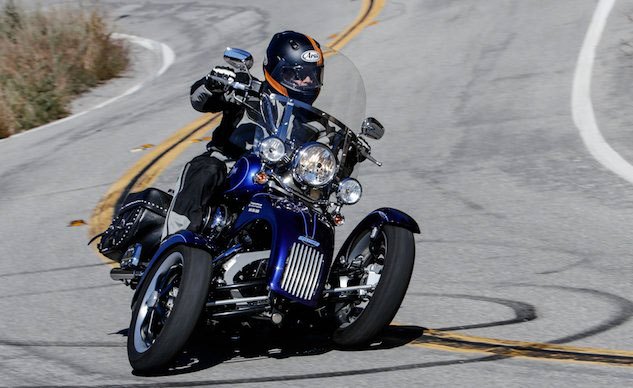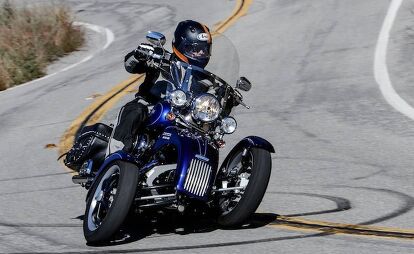Ask MO Anything: Will There Be More Tilting Trikes?
Dear MOby,
So, I’ve read a ton of stuff about tilting trikes, but barring the one conversion company, tilters are all scooters. Will there be major manufacturers’ support for these in the near future?
Thanks!
Steve Traynor
17 years of enjoying The Morons!
Dear Steve the Enjoyer,
We wouldn’t be surprised to see more tilting motorcycles as we Boomers (the ones with all the dollars) move into our dotage, especially seeing how well all the non-tilting trikes like the Can-Am Spyder have been selling. We already knew a lot of of us were unhinged before the current election cycle; now we’ve been made aware of how many of us are downright unbalanced.
By “the one conversion company” you mentioned, do you mean Tilting Motor Works? Tom and the kids already tested its Trio earlier this year in his seminal work Three-Wheeler Threeway, wherein everyone came away mostly impressed. (That’s it in the lead photo.) That test involved a Harley Softail conversion, but TMW also sells kits for other Harleys and Honda’s Gold Wing, Valkyrie, and F6B.
What are the advantages to a tilting three-wheeler vs a typical trike? It so happens TMW sent us a press release earlier this year, and we quote:
Physical demands. Because conventional trikes and Spyders corner by steering rather than countersteering, they require significantly greater reach and strength to maneuver than does a Trio. The Spyder rider is actually bracing himself against the handlebars to get around the corner, using his full reach, while the vehicle gets light on the inside wheel.
Passenger comfort. On a conventional rigid trike or Spyder, passengers require grab rails to counter centrifugal forces when cornering. In fact, the Can Am Spyder employs elaborate Bosch-designed traction controls to counter these forces. By contrast, the forces acting on a passenger on a Trio are the same as those on a motorcycle, allowing for a neutral, relaxed riding position.
Agility. Conventional rigid trikes are often heavy and underpowered by design to reduce the potential for rollover. This factor, combined with the physical demands these vehicles present, means that many new trike riders discover it’s difficult to keep up with their two-wheeled friends any longer. By contrast, the extra cornering traction on a Trio conversion means it can usually outrun the stock two-wheeler through the turns.
Handling. With so much weight to the rear of the vehicle, handling can feel skittish on a conventional rigid trike. One front motorcycle tire doesn’t always offer enough traction to redirect a 1200-lb. vehicle and its riders at speed, sometimes resulting in a dangerous loss of control. The steering dampers and rake kits offered with conventional three-wheel conversions exist only to mitigate this skittishness.
TMW’s release goes on, but you get the gist. The release also reminded us of Harley’s own failed leaning-bike, the Penster, which now resides in the H-D Museum. The Penster was reportedly farmed out to famed hot-rodder Lil’ John Buttera, who died in 2006.
After more than a few failed prototypes, H-D apparently decided the Tri-Glide and Freewheeler was a better idea than the Penster.
2015 Harley-Davidson Freewheeler Review
Shirley you didn’t miss our coverage of Honda’s Neowing last year?
Powered by a hybrid thrust system, the Neowing concept reportedly uses a flat-Four boxer and an electric motor. Dennis Chung dug up the patent application for its front end nearly two years ago here, slightly different than what Piaggio uses in its MP3 scooter.
Honda says, inscrutably as always, “Sometimes concepts are shown at motor shows to tease a future model, and other times concepts are shown to study a specific design direction. Clearly there is research being done in this area, but research doesn’t always lead to a production model.”
Speaking of the Piaggio MP3, we also wrote it up here in addition to it being included in the Three-Wheeled Threeway linked to above. You can diss it as being a scooter if you must, but it’s a 493cc, 577-pound scooter that’ll carry two big people and their stuff at well over 90 mph, which is motorcyclely enough for us.
And speaking of the Can-Am Spyder, they haven’t done it yet but the rumors have been rumored, and BRP applied for the patents to make its own tilting trike back in 2011.
Need something a bit more car-like? Have a look at the TerraCraft, designed and built in Houston, Texas. Straight from the website’s mouth: The TerraCraft supertrike intelligently determines how many people are on board and the center of mass, how fast you are going, the angle of the turn you are making, the g-forces that are being incurred and external environmental conditions the vehicle is experiencing, then will automatically tilt the vehicle so you grip the turn, stay balanced and carve through the turns even during acceleration. The ILCS system coupled with the aerospace technology, independent steering, hardware and science make the TerraCraft the extreme exotic super-trike that rides like a bike.
But does it have cruise control?
Basically, we can safely say more tilting three-wheelers are on the way simply because people have been experimenting with them since not long after the invention of the first tilting two-wheeler. And when there’s enough money to be made, you can be sure the big factories will be there to make it. Them. Now’s a better time than any.
Dive in here if you must for a little more history. And don’t forget the leaning sidecar while you’re at it.
More by John Burns









































Comments
Join the conversation
I'd like a hybrid design of the Gurney Alligator and the MP3. Something different yet stable for these aging bones.
What about this? https://www.google.com/amp/...
https://uploads.disquscdn.c...